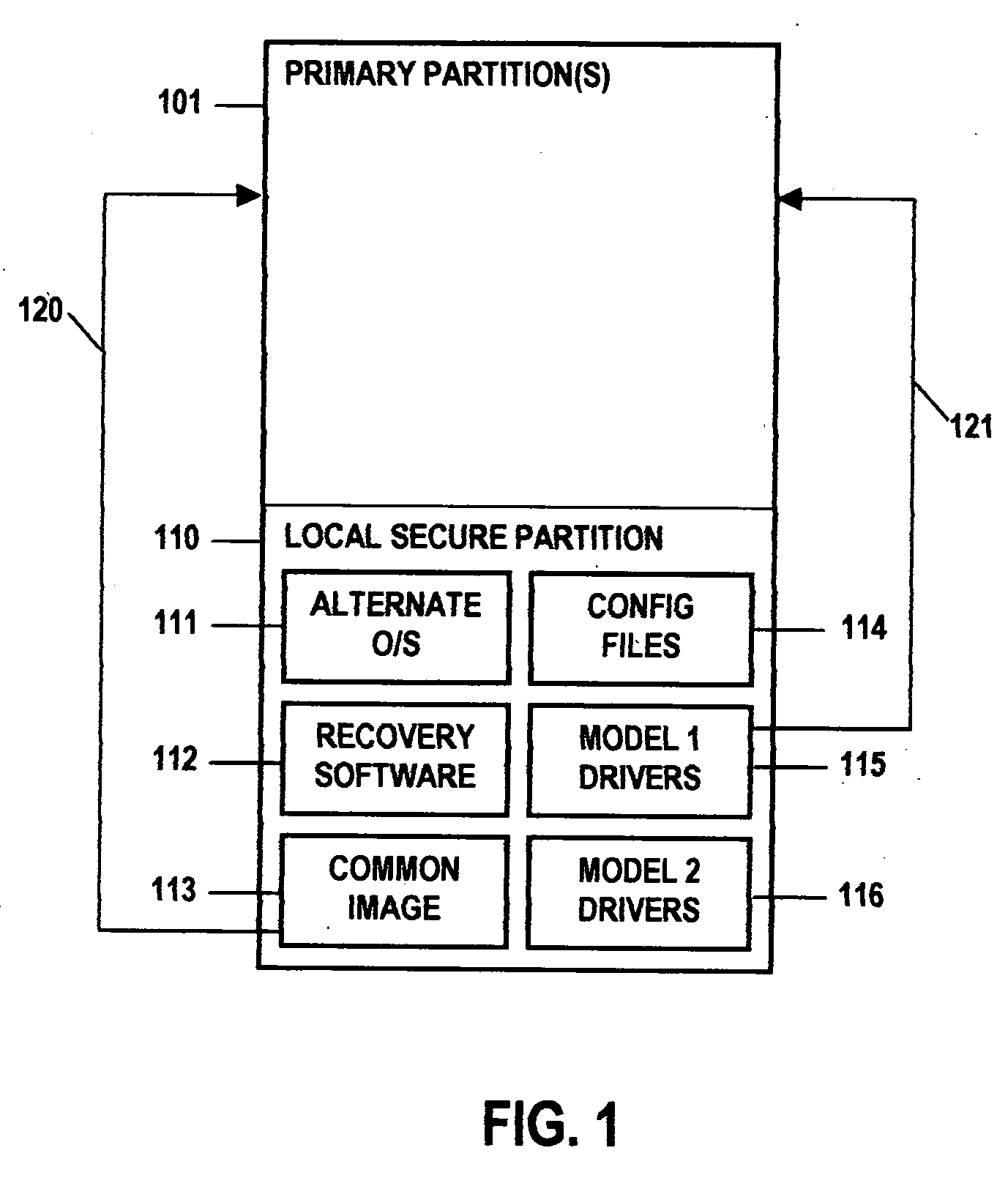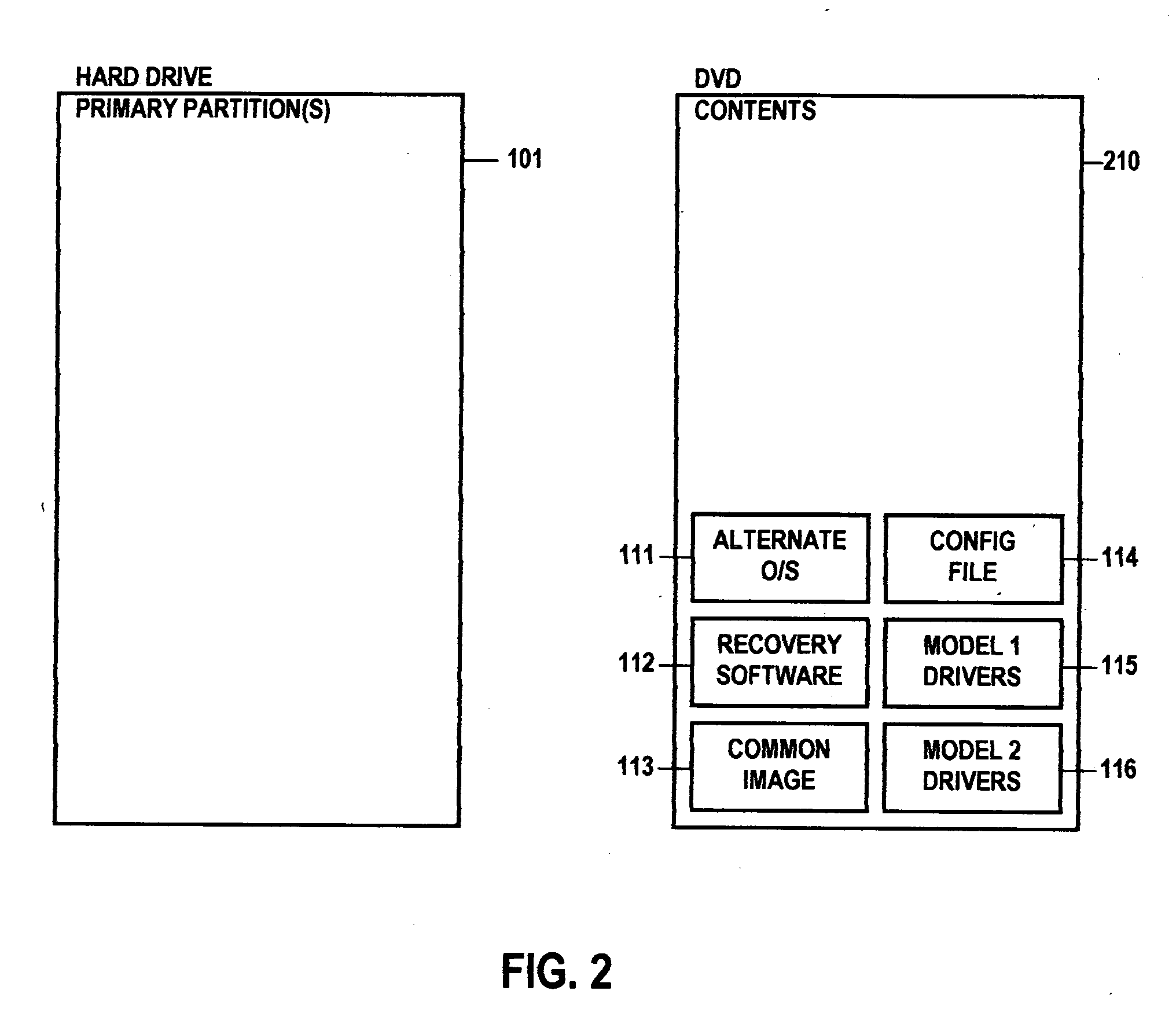[0013] One
advantage of the present invention is that the present invention allows for updating computers to a known state image. These computers are considered running in an unknown state and assumed to have user data stored on the local storage medium which needs to be maintained. One of the disclosed methods adds new or updated software to devices already deployed by pushing software updates through the primary operating
system using well-known software techniques. To overcome previously described limitations with this method, the present invention does not apply the updates via the “dirty” primary operating system but uses a process to ensure devices are at a well-known state before the updates are made. The present system keeps track of each sector-by-sector change that occurs on the device's local storage medium. This is utilized to enhance the performance of the current invention, however could also be performed through changing all the sectors on the drive based upon the well-known image. When a device needs to be upgraded with a new set of software, the present system uses the following steps. First, the present system takes a
delta snapshot of the device to capture all new data that is on the device referred to as “user data” as well as any computer and user specific information referred to as “local settings” and puts this information into a known location, such as a secure partition. The present system may perform this first step from the alternate operating system (preferably in the secure partition), therefore not requiring the primary operating system to be operational when this process occurs. Second, the device is rolled back to the original image by restoring only those deltas to the device that have been modified since the original image. The present system keeps track of which sectors of the local storage medium have been modified since the original image was restored and only recovers this
delta set of sectors. This method greatly reduces the time needed to recover back to an earlier image. However, the current invention is still relevant if the whole image of the well-known image is restored. Third, the device is brought back to the last
software update level by recovering a locked down incremental restore point that represents the last approved update level. Fourth, the new software updates are applied to this clean state. Please note that these software updates may either be applied through prior art
software distribution techniques or through an additional delta pack of the current invention being layered on top of the last known-state image. Fifth, the “local settings” captured in the first step are reapplied. Sixth, another locked down incremental snapshot is taken to capture the new approved update level to allow the entire process to occur again later when there is another set of software updates available. Lastly, the “user data” captured in the first step is re-applied to the device.
[0014] It is possible to change some of the order above and achieve similar results. For example, it is possible to not apply the local settings back to the running image prior to taking the new snapshot for your new locked down point, and restoring this information at the same time the user data is restored.
[0015] A variation on the updating method used by the present system works when the original image or locked down point image are replaced with a new delta pack and already contain the update which is provided in
step number 4 in the
paragraph above. In this case, the distribution of the new functionality is no longer required to be distributed, and there is no longer a requirement to take a new snapshot for the locked down point as this would already be well-known as it was deliberately distributed.
[0016] A variation on the updating method used by the present system, works on devices that do not store user data locally, but instead store any user data on a network resource. Even when user data is not stored locally, the local image is constantly changing for reasons, which have been previously described. The present system stores a copy of the original software image, preferably in a secure partition on the local storage medium. The device never runs from this original image, assuring that recent security patches are applied before it becomes operational. All patches and software updates are applied to this original software image, preferably after it has been recovered into the primary partition.
[0017] The patches and software updates, known collectively as the delta
package, are stored separately from the original software image (which is preferably in the secure location on the local storage medium) to allow the device to be recovered either to the original image or to one of a set of image levels. Each image level representes a different set of delta packages, with the first image level being the original deployed software image before any delta
package was applied or a new image that has been designated as the new base image. This may be utilized in a situation where the core image has been in the field for a period of time and requires a large amount of changes, which an organization may want in their core image. An example would be to roll up all security patches released over the last year and create a new core image. This image could be remotely distributed and become the new baseline for the current invention. With the present system, the device can be rolled back to any of these image levels at any time, even if the running image no longer boots properly into the primary operating system.
[0018] The present system puts the delta
package into storage (preferably the secure location) either while the primary operating system is running or when an alternate operating system is running. By putting the delta package in the secure location while the primary operating system is running, the device can perform its normal operations while updates are staged in the secure location. The secure location stores an alternate operating system that is booted to perform operations such as recovering the primary operating system. In addition, this alternate operating system can collect the delta package. This allows the device to receive the delta package even if the primary operating system environment is not able to run properly to receive the delta package. One example where the alternate operating system needs to be used to receive the delta package is when the primary operating system has a security issue that requires the delta package to resolve. If the security issue is significant enough to prevent the transfer of the delta package in the primary operating system environment, the present invention can still get the delta package to the local secure location by running from the alternate operating system environment. Once the delta package is in the secure location, the device can be recovered to the latest image level that includes this delta package with the security patch.
 Login to View More
Login to View More  Login to View More
Login to View More 


